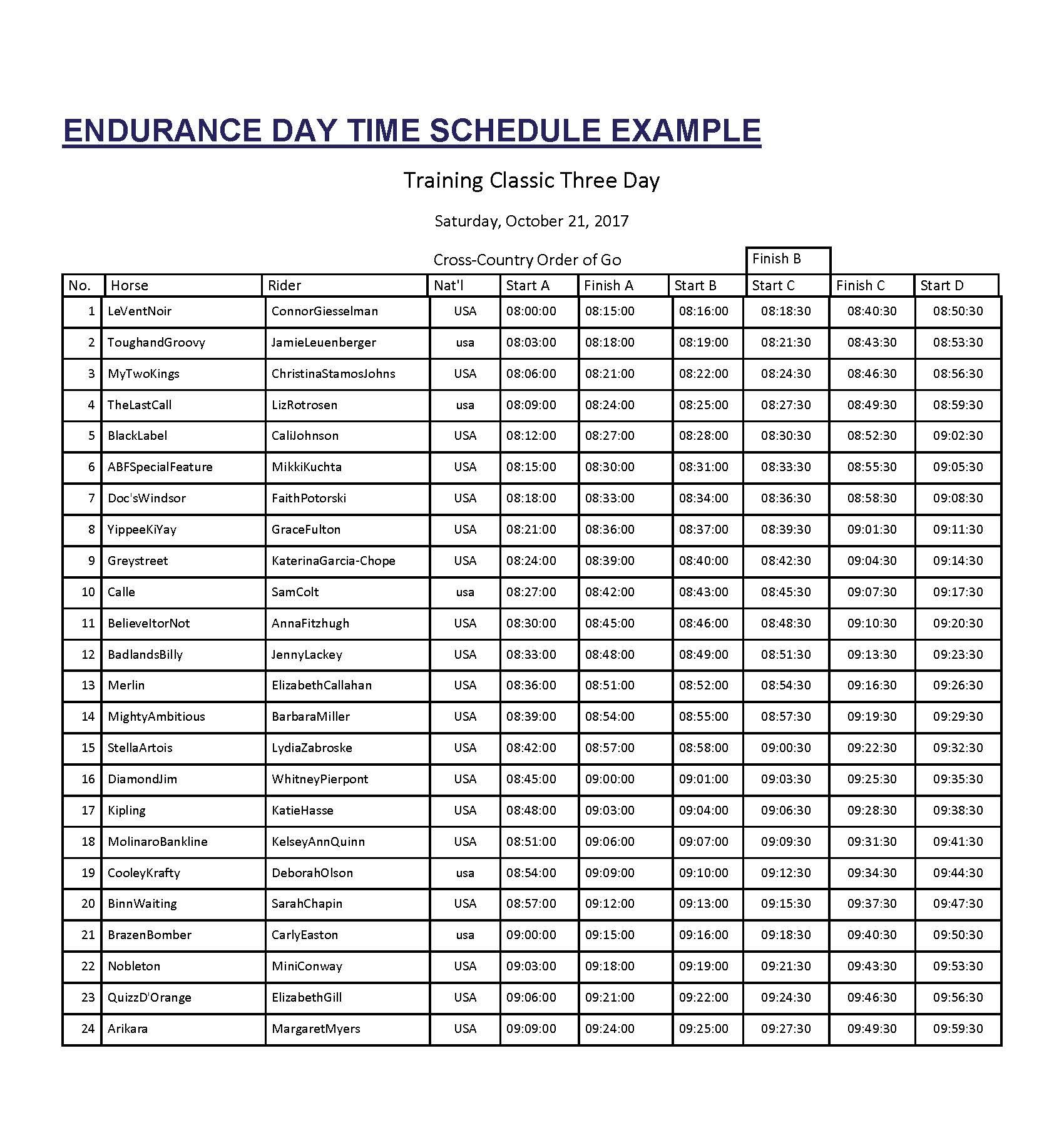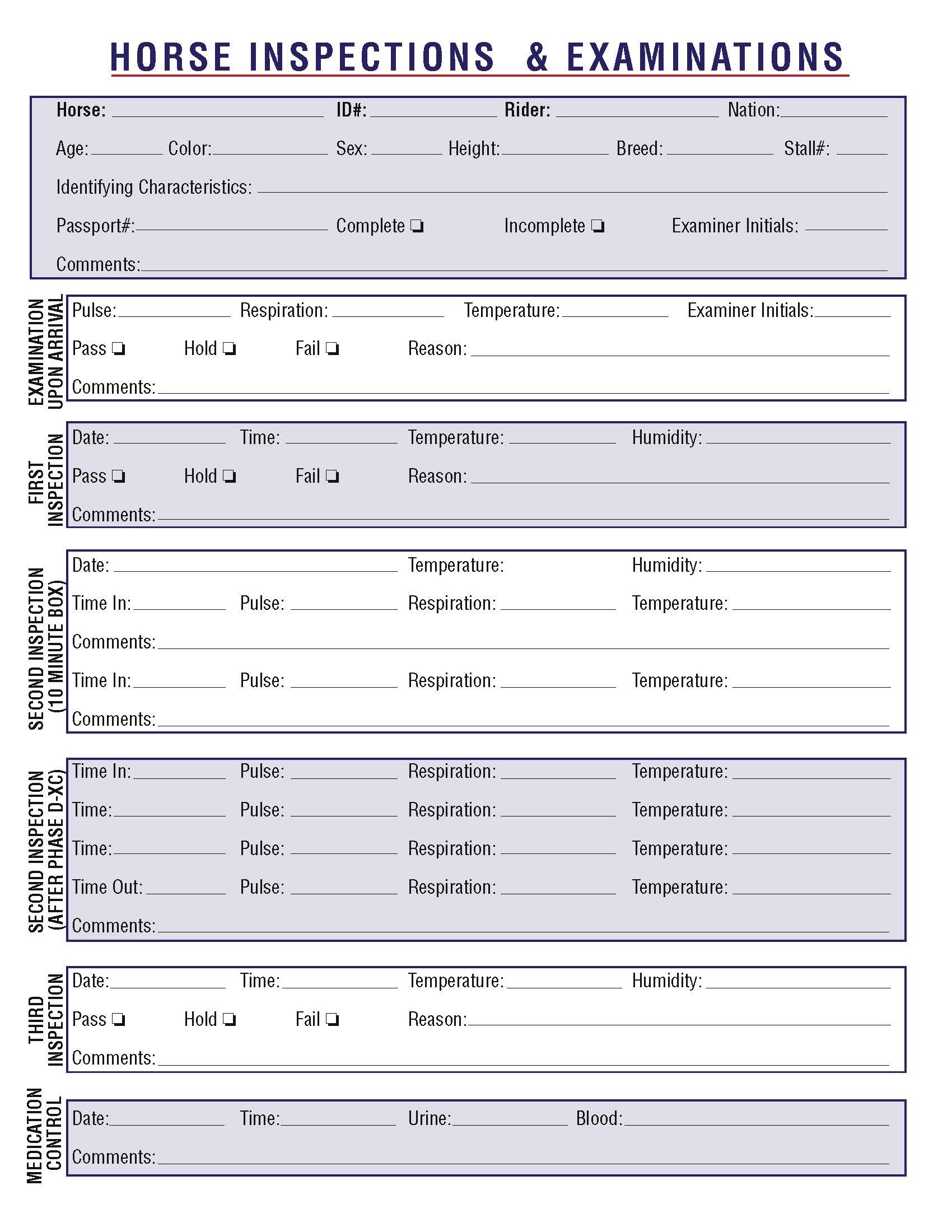USEA Classic Series Guidelines
Effective October 21, 2025
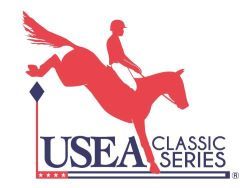
Purpose
This manual contains the USEA guidelines for Organizers hosting Classic Three-Day events. These guidelines provide clarifications to the USEF Rules for Eventing that govern the Training Three-Day Event (T3D), Modified Three-Day Event (M3D), and Preliminary Three-Day Event (P3D). Section 151 within the Rulebook is dedicated to the rules for Classic Three-Day Events. The Guidelines explain the exceptions for the Beginner Novice Three-Day Event (BN3D) and Novice Three-Day Event (N3D) under Eventing Tests.
History
Eventing became an Olympic sport at the Stockholm Olympic Games in 1912. It was only open to amateur riders who were in the military. The purpose was to test the cavalry on their fitness and suitability. Dressage showcased skills from the parade ground, and the jumping phases demonstrated speed and stamina. At the 1912 Olympic Games in Stockholm, the eventing competition was held over five days, with endurance on the first day, steeplechase on day three following a day of rest, followed by show jumping on day four and concluding with dressage on day five. In the 1924 Olympic Games in Paris, France, eventing adopted a format that more closely resembles that of today’s Classic Three-Day events. Dressage was held over the first two days, followed by endurance day, which contained five phases – A, B, C, D, and E, and concluding with show jumping on the final day. The ten-minute rest period between phases C and D was introduced in 1963, and phase E – a 1.25-mile sprint – was removed in 1967. For many years a point system was in place that rewarded riders for coming in under the optimum time, but this system was abolished in 1971. In 1986 the need for many Competitors having to compete with weight pads was removed. The next major change came to the sport in 2004 when the short format was introduced at the Athens Olympics. The Badminton Horse Trials, the Kentucky Three Day Event and the Burghley Horse Trials all ran their last long format events in 2005. There has been a strong swell of dedicated Organizers, who believe the training for the Classic format is a critical component, hosting Classic Three-Day Events with a focus on education. The evolution of the sport at the Olympic level will continue, but the value of preparing for and riding in a Classic Three-Day has not been diminished as a test of fitness and suitability for the sport.
Guidelines for Education
The USEA Classic Three-Day Task Force strongly recommends Organizers of the Classic long-format three-day event provide educational clinics for Competitors to foster a positive and safe competition experience for all. Supervised schooling prior to the start of the test over parts of the steeplechase course and riding the roads and tracks phases is encouraged. The Ground Jury, Technical Delegate, Veterinary Delegate and either professional trainers on site or hired clinicians may assist in teaching educational sessions. An Organizer may decide whether the sessions are optional or mandatory, but they should be open to all Classic Competitors and scheduled for times that are appropriate and convenient to encourage maximum attendance. For additional advice on how to plan and execute educational clinics during your Classic event, Organizers are encouraged to consult experienced Classic Event Organizers.
Organizers are urged to offer the following minimum educational sessions before or during a three-day competition:
- How to present your horse at a formal horse inspection (jog practice)
- Supervised steeplechase practice
- Navigating/timing on roads and tracks
- Guide to the vet box
- Endurance day aftercare
- Cross-country and show jumping course walks
Organizers may also opt to distribute useful information to Competitors in advance of the competition, such as how to determine your horse’s fitness level, a conditioning schedule, nutritional information, and what to pack for a Classic Three-Day event. Articles covering these topics and many more related to Classic Three-Day events may be found on the USEA website.
Levels and Qualifications
Beginner Novice Classic Three-day Event (BN3D): Open to Competitors of any age, on horses 4 years of age or older. The Competitor and horse together must achieve one or more Minimum Eligibility Requirements (MERs) at a recognized Beginner Novice level or higher horse trials or event. A Competitor established at the Training Level may compete on a horse which has obtained a MER at the Beginner Novice Level or higher with a different rider. All qualifying competitions must be completed within 24-months of the start of the competition.
Novice Classic Three-day Event (N3D): Open to Competitors of any age, on horses 4 years of age or older. The Competitor and horse together must achieve one or more Minimum Eligibility Requirements (MERs) at a recognized Novice level or higher horse trial or event. A Competitor established at the Training Level may compete on a horse which has obtained a MER at the Novice Level or higher with a different rider. All qualifying competitions must be completed within 24-months of the start of the competition.
National Three-Day Events (P3D, M3D, and T3D). Qualifications are in accordance with the USEF Rules for Eventing Appendix 3.
Guidelines for Structure
Events choosing to host a Classic Three-Day should plan to run the tests in traditional order with one test on each consecutive day. Unforeseen environmental conditions, such as storms, may require an event to adjust the order for safety reasons.
Days:
- Dressage Test
- Cross Country Test is comprised four phases often referred to as Endurance Day:
- Phase A – Roads and Tracks
- Phase B – Steeplechase
- Phase C – Roads and Tracks
- Phase D – Cross-Country
- Show Jumping Test
- Held the day after the endurance day.
Ideally an Organizer will run with enough officials and divisions so that all Dressage can occur on a single day with the Endurance test on the following day. It may be necessary to spread Dressage over one or more consecutive days, depending on the number of Competitors and organizational constraints.
Endurance Test:
Phase A: First Roads and Tracks -Generally, Phase A is the shorter of the two roads and tracks phases and is used as a 10-20-minute warm-up. It will be well marked with compulsory flags, referred to as “gates”. The terrain can be varied, including trails, fields, creek crossings and even quiet roads. All terrain should be suitable for trotting with opportunities for canter. Start times are assigned. All levels use the same speed of 220 meters per minute. Finishing Phase A early provides the Competitor a few extra seconds/minutes to prepare for Phase B.
It is acceptable for Roads and Tracks to repeat portions of the track. Care should be taken to ensure the track is wide enough for horses to pass each other safely. Care should also be taken when laying out the track to avoid Competitors having to remember how many times they have done a loop. The gate markers and kilometer markers enable Competitors to confirm they are on the correct track at the desired pace.
Phase B: Steeplechase - Steeplechase is made up of brush jumps intended to be jumped at speed with minimal adjustment of the horse's balance and pace prior to the fence. As such the jumps should have a defined groundline well forward of the maximum fence height. Beyond the level specification tables within this guide, please see the Cross-Country Obstacles Guidelines for details on appropriate dimensions for brush fences. The Organizer may choose at the Beginner Novice level to not offer steeplechase fences on this phase. At all other levels, the steeplechase fences should be at the appropriate height for the level.
The Steeplechase Start may consist of a Start line or a Startbox based on the Organizer’s preference. Regardless of steeplechase start type, horses should be started the same as they are for the Cross-Country start, noting that a “flying start” is not acceptable.
The scheduled start time for Phase B is one minute after the scheduled finish Phase A. Competitors should not start Steeplechase early, even if they finish Phase A early. Instead, they may use the additional time before they start to adjust equipment, receive last minute coaching, receive hydration, establish the canter needed for steeplechase start, etc. If the Competitor is late finishing Phase A, the one-minute break will be decreased accordingly with some exceptions outlined in
See EXPLANATION OF INDEPENDENCE OF PHASES below. The Competitor’s actual finishing time of Phase B is used as the actual start time of Phase C.
Phase C: Second Roads and Tracks - Generally, Phase C is up to a third longer than Phase A; lasting 15-35 minutes over similar terrain as Phase A. When Phase A and C share portions of the same track, it is important that the compulsory flags for each Phase are clearly identifiable with the Phase and gate number. The Organizing Committee may take into consideration environmental factors, time of year, and skill of Competitors when choosing the speed for Phase C. They may choose a speed of 160 meters per minute or 220 meters per minute uniquely for each level.
Reminder: The finishing time of Phase B is also the starting time of Phase C. The optimum time of Phase C is not affected by the gain or loss of time on Phase B. For example, a gain of 10 seconds on Phase B does not give the Competitor an additional 10 seconds to complete Phase C.
There will usually be an assistance area early on Phase C where the support crew can offer water or snacks to the horse and/or athlete. The Phase C clock does not stop while the Competitor is in the assistance area – so don’t dottle. They may assist in adjusting tack, checking the horse’s shoes, etc. It is recommended to have duct tape or an easy boot to resolve any lost shoes while in the assistance area of C. The Farrier can meet the Competitor at the ten-minute box to replace any lost shoes before the start of phase D.
Phase D Cross-Country - This course should be consistent in length and complexity with a Horse Trials cross-country course for the level with an optimum time between 5-7 minutes. If the Classic Three-Day is running alongside a Horse Trials, Phase D should not be shorter than the Horse Trials cross-country course. Course Designers are encouraged to make some variation between the cross-country courses for the Horse Trails and the Classic Three-Day. The complexity of Phase D may include level-appropriate questions that would be seen on a championship course. The difficulty of the cross-country shall be referenced in the Omnibus. Reference the USEF Rules for Eventing APPENDIX 8 - SPECIFICATIONS FOR THREE DAY EVENTS for Training, Modified and Preliminary Classic Three Days, and the Specification Table in these guidelines for Beginner Novice and Novice.
Unique Considerations for Roads and Tracks
Compulsory Passages are often referred to as “gates”. The gates shall be marked with the relevant letter of the Phase and numbered consecutively from the start of the Phase. In addition, there shall be Kilometer Markers. The routes of Phases A and C should be marked at intervals of 1000 meters by signs. The signs include the Phase letter and shall indicate the distance from the start of the Phase. If there are variances in Roads and Tracks for the levels, the variance shall be clearly identified by color and/or level. Course maps are required for Roads and Tracks.
The Organizing Committee may allow Competitors to hack the roads and tracks prior to endurance day in order to develop familiarity with the track.
Failure to pass through the marked gates that is not corrected will result in Elimination. However, unauthorized assistance does not apply to gate judges. Gate judges should be briefed to proactively engage with the Competitors including to advise a Competitor that may have missed a gate to come/go back and go through a gate.
Between the starts and finishes of Phases A and C, Competitors are free to choose their own pace. They may dismount and proceed on foot beside their horse at any time, including while negotiating compulsory passages, except that they must be mounted to pass through the start and finish flags of both Phases. The rules for pace and dismounting on Phase B and Phase D are the same as those for the cross-country test of a Horse Trial.
Attire and Saddlery
Attire and saddlery should be in accordance with the current USEF Rules for Eventing.
Dressage and Show Jumping. Competitors at all levels are encouraged to wear jackets in the in Dressage and Jumping test of the Classic Three-Day unless the Ground Jury or Organizer has specifically waived jackets for the phase. An appropriate whip can be carried during the Dressage Test.
Endurance. Attire shall adhere to the standards set for Cross-Country for all phases. Inflatable vests are permitted only when worn in addition to a body protecting vest during any phase.
Specifications for Levels
For Classic Beginner Novice Three-Day and Novice Three-Day – See Table 1: Classic Three-Day Specifications below.
For Classic Training Three-Day, Modified Three-Day, and Preliminary Three-Day - See USEF Rules for Eventing Appendix 8: SPECIFICATIONS FOR THREE DAY EVENTS
Dimensions—For cross-country and jumping obstacles - see Appendix 2. Also see USEA Cross-Country Design Guidelines for cross-country and steeplechase obstacles.
Table 1: Classic Three-Day Specifications
| Beginner Novice Three-Day | Novice Three-Day | |
| Dressage USEF Eventing Tests | Beginner Novice 3D – Standard or Small with one or two judges | Novice 3D - Standard or Small with one or two judges |
| Phase A Distance | 2200 – 3520m | 2200 – 3520m |
| Phase A Speed | 160 mpm or 220 mpm | 160 mpm or 220 mpm |
| Phase A Time | 10-16 minutes | 10-16 minutes |
| Phase B Distance | 800 - 1200m | 940 – 1410m |
| Phase B Speed | 400 mpm | 470 mpm |
| Phase B Speed Fault | 470 mpm | 540 mpm |
| Phase B Time | 2-3 minutes | 2-3 minutes |
| Phase B Jumping Efforts | 0 – 6 (optional for this level; to be published in the event prize list). 3’0” maximum brush height; 6” minimum of brush. | 3 – 6 3’7” maximum brush height; 6” minimum of brush. |
| Phase C Distance | 2400 – 4480m | 2400 - 5500m |
| Phase C Speed | 160 or 220 mpm | 160 or 220 mpm |
| Phase C Time | 15-28 minutes | 15-34 minutes |
| Phase D Cross-Country | XC heights & spreads - same as H.T. level. Refer to Appendix 2 | XC heights & spreads - same as H.T. level. Refer to Appendix 2 |
| Phase D Distance | 1625 – 2450 m | 2200 - 2700m |
| Phase D Speed | 325 or 350 mpm | 375 or 400 mpm |
| Phase D Speed Fault | 420 mpm | 450 mpm |
| Phase D Time | 5-7 minutes | 5-7 minutes |
| Phase D Jumping Efforts | 16 - 22 Not more than one effort per 100 meters commenced. | 18 - 25 Not more than one effort per 100 meters commenced. |
| Show Jumping | Same as H.T. level. Refer to Appendix 2. | Same as H.T. level. Refer to Appendix 2. |
Inspection & Examination of Horses
There are 4 inspections. Examination upon Arrival, First Horse Inspection before Dressage, Second Horse Inspection during the ten-minute box after Phase C and before Phase D, and the Third Horse Inspection prior to Show Jumping.
The first and third horse inspection. The horse should be presented in a bridle. The handler may carry a whip no longer than 120 centimeters including lash. No other equipment may be used during the inspection. The horse should be well groomed and presented without wraps of any kind on legs or tail. Braiding is optional. The handlers tend to dress up, expressing their personal style for these two inspections. The attire chosen should not restrict the handler’s ability to safely and effectively handle the horse who may not be on their best behavior. It is expected that the Competitor will present their own horse at the First and Third horse inspection. The Competitor may request permission from the Organizer or Ground Jury to have an alternative handler to present the horse to these inspections. Should an alternative handler be used, the Competitor must also be present, and accompany the horse should it be sent to holding.
In barns and second horse inspection (between phases C and D). The horse maybe be presented in halter or bridle (or both). The handler should be dressed in appropriate workman or barn attire. It is not uncommon for an alternative person to handle and present the horse during the Second horse inspection. See TEN MINUTE BOX below for further details.
The Ground Jury, as a committee, may prohibit a Competitor from continuing the competition at any point, if they feel the horse or Competitor are unable to continue safely.
Veterinary Role
In-Barns: Horses are checked over by the Veterinary Delegate or appointed Veterinarian. The exam will include checking vitals (temperature, pulse, respirations) and glancing over the legs and body for any pre-existing conditions. The Veterinarian will document the horse’s vitals and make notes about any pre-existing conditions and the general overall condition of the horse. The findings are recorded, and the document follows the horse throughout the competition. An example of the HORSE INSPECTIONS & EXAMINATIONS Form is provided at the end of these guidelines.
First & Third Inspections: The Veterinarian will share pertinent information with the Ground Jury as the horse is presented. Where possible, a secondary Veterinarian should be available to examine the horse in the hold area if there is a question of soundness as determined by the Ground Jury. In the hold area, the Veterinarian shall examine the horse, talk to the Competitor about the horse and get some history, then report back to the Ground Jury before the horse is represented. Time shall be built into the schedule to address any horses sent to holding. The decision to represent or retire is solely with the Competitor.
Ten-Minute Box: The Veterinary Delegate stays in vet box for the duration of cross-country. Each horse will come into the vet box and jog prior to being released from the ten-minute box. The Veterinarian is typically accompanied by three Veterinary assistants (preferably Veterinary Technicians) and three Volunteers to keep time and track of the horses. The Veterinarian and/or Veterinary Assistants take the horse’s vitals and record the results on the “Horse Inspections & Examination” form. The Veterinarian and a member of the Ground Jury watch the horses trot into the ten-minute box as they enter the box. Horses are checked again at six minutes, and then if all vitals have come down, they are released to the individual keeping the time on the horse. At eight minutes, the timekeeper advises the Competitor so that they can be put up on the horse and prepare to start cross-country on time; just 10 short minutes after they finished Phase C. Ultimately, it is the Competitor's responsibility to get to the cross-country start on time!
D Recovery Box: Once the Competitors finish cross-country, they come into a vet box for the horse to be cooled down and determine if they can return to their stall. The Veterinarian is available to assist any horse in the recovery box if needed.
Time Calculations & Explanation of Independence of Phases
Optimum Time: Optimum time is calculated for each phase by taking the total distance and dividing it by the speed for the phase. The optimum time is also used to create the timetable. A sample timetable is at the end of these guidelines.
Reminder: The Course Designer is encouraged to set the distance on Phases B and C so that the optimum times of these phases, plus the mandatory ten-minute box, results in Phase D starting on the top of a minute.
Time Limits
- On Phases A and C, the time limit is one fifth more than the optimum time.
- On Phase B and D, the time limit is twice the optimum time.
Time Faults
- On Phases A and C, exceeding the optimum time will be penalized at 1.0 penalty point per second.
- On Phase B, exceeding the optimum time will be penalized at the rate of 0.8 penalty point per second.
- On Phase D, exceeding the optimum time is that same as cross-country at Horse Trials. It will be penalized at the rate of 0.4 penalty points per second.
Speed Faults
- On Phase B for Beginner Novice, Novice, and Training, each second under the speed fault time will be penalized at 0.4 penalty points per second.
- On Phase D for Beginner Novice, Novice, and Training each second under the speed fault time will be penalized at 0.4 penalty points per second.
Timetable Explanation of Independent Phases
See USEF Rules for Eventing Sub-Chapter EV4-Rules for Events EV176 Three Day Events – Rules paragraph 6.
The timetable shall be provided to each Competitor. The timetable includes a start and a finish time for each phase based on optimum time. For the benefit of all parties, the Course Designer should work to have the course lengths adjusted to fit neatly into a time schedule where horses start at the top of the minute for Phases A and D. The scheduler should build in a one-minute gap in the schedule between Phase A and Phase B. There is also a ten-minute mandatory gap between Phase C and Phase D.
Phases A, B, C and D are quite independent of each other as far as the timekeeping is concerned. Loss of time in one cannot be compensated for by gain of time in another. Below is a summary with examples of how time works.
Competitors start Phase A on their scheduled time. The Competitor is also expected to start Phase B on their scheduled time. If the Competitor completes Phase A early, the one-minute break before the start of Phase B will be increased accordingly. If the Competitor finishes Phase A late the break before Phase B will be reduced with some exceptions:
- For example, if the Competitor finishes Phase A 20 seconds late, their break will be only 40 seconds.
- If a Competitor is so late finishing Phase A that he cannot start Phase B on time, he will be started on Phase B as soon as safely possible. The Phase B start will be adjusted to the actual time the starter instructs them to start. This information must be shared with the Controller and Phase D start, as they may need to adjust the Phase D start time accordingly.
- IMPORTANT REMINDER: The optimum time for each subsequent Phase is NOT adjusted. The Competitor who is late finishing any Phase need not attempt to regain the time lost.
The gaining of any time on Phase B and/or Phase C WILL result in additional resting time added to the ten-minute compulsory hold provided for the Second Horse Inspection before the start of Phase D. The loss of any time on Phase B and/or Phase C should not substantially reduce the ten-minute compulsory hold. The Competitor’s starting time for Phase D may have to be adjusted if a Competitor is significantly late from their scheduled finish for Phase C. However, if this delay is small (i.e., the Competitor was less than a minute late finishing Phase C), the Competitor may be started on Phase D at their scheduled time, in order not to interfere unduly with the timetable of the Competitors behind them.
Note: The Competition Management must be sensitive to other starters and assure that those starters times are not unduly affected by a “fill” in starter.
Scoring
Dressage: When there are two judges (one at C and one at E/B) it is preferable to list the percentage scores for each judge, and then the final average penalties for use on the scoreboard. The lead judge is always at C and their result should be posted first. Here are two examples:
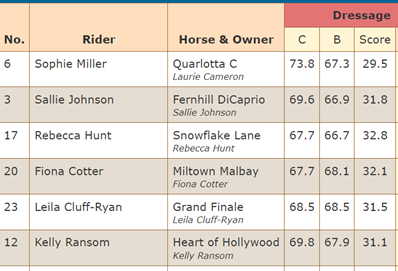
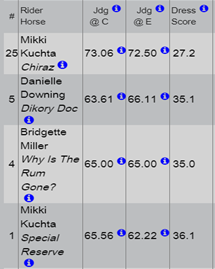
Endurance and Final Results: Each Phase of the Endurance Test shall be recorded separately. These include:
- Phase A – Time Faults
- Phase B (Steeplechase) – Time Faults and Jump Faults including Dangerous Riding
- Phase C – Time Faults
- Phase D (Cross Country) – Time Faults and Jump Faults including Dangerous Riding
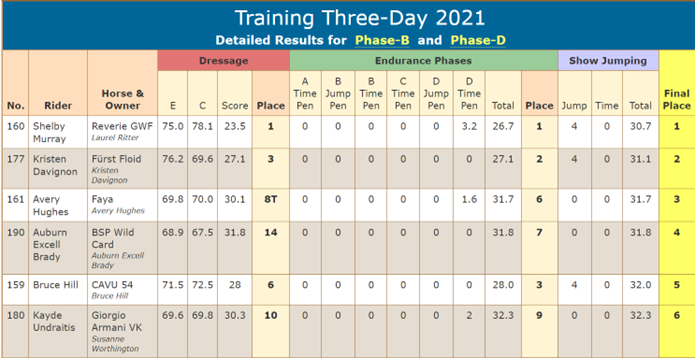
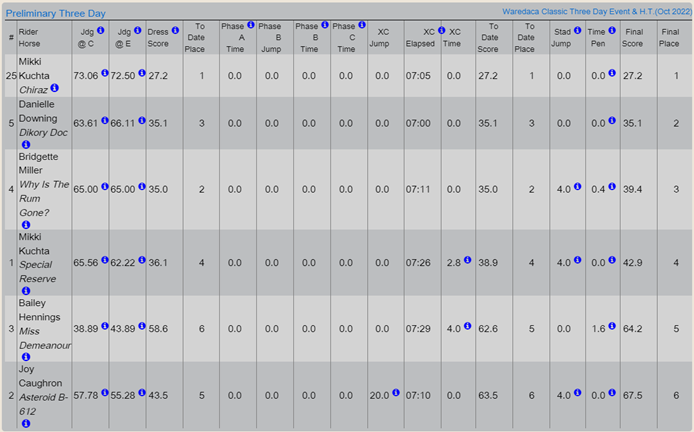
Actual elapsed time and details regarding jump faults for Phase B and Phase D shall be available online or via a master control sheet posted on the scoreboard to aid Competitors who wish to inquire about their results.

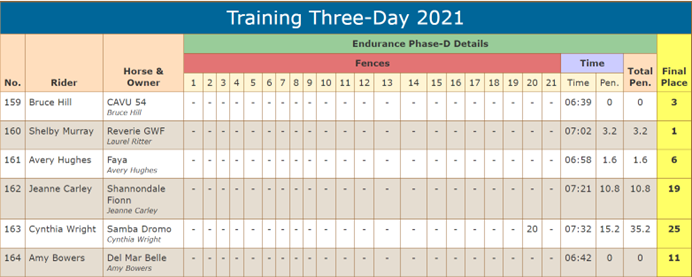
Awards Classification
There should be an awards ceremony following Show Jumping. There are often many special awards like Best Conditioned, Adult Rider, Young Rider, Best Turned Out and/or breed awards. Awards ceremonies are very important to Sponsors and Spectators, and Competitors are encouraged to participate. The Organizing Committee will determine the number of horses that are to remain in the area for presentation of awards and victory gallops following the jumping test.
Individual Final Classification: The winning individual is the Competitor with the lowest total of penalty points, after adding together, for each Competitor, the penalty points incurred.
In the event of equality between two or more Competitors, the classification is decided in the same manner as a Horse Trials by:
- The best Phase D score including faults at obstacles, time penalties, and any other penalty that the Competitor may have incurred during cross-country.
- If there is still equality, the classification is decided in favor of the Competitor whose cross-country time was closest to the optimum time.
- If there is still equality, the classification is decided in favor of the Competitor with the best show jumping score including penalties at obstacles and time penalties.
- If there is still equality, the classification is decided in favor of the Competitor with the best collective mark(s) in the dressage test.
- If there is still equality, the tie will remain in the final classification.
Teams: Team competitions are common at Classic Three-Day events. The winning team is that with the lowest total of penalty points, after adding together the final scores of the three best scores in the team. In the event of equality between any two or more teams, the winning team will be that whose third placed Competitor has the best score. If that is equal, the team remains tied.
Organizers Helpful Hints & Checklist
Early Preparations:
- Submit request to hosting a Classic Three-Day the same as you do for a Horse Trials.
- Add dressage tests, speeds and distances for Phases A, B, and C to your Omnibus listing
Hiring Officials:
- Decide if you will use more than one judge for the dressage. Many Classic Series events do and so both will officiate at the horse inspections.
- Consider hiring at least one Official with Classic Series experience.
- Determine if your Veterinarian has experience with a Classic format.
- Hire additional staff to support the Veterinarian. They will assist with the arrival exams, the horse inspection and the ten-minute box.
- Determine if your cross-country Course Designer will design or if someone else will layout Phases A, B and C.
- Determine if you will need an additional Farrier(s) for endurance day. They should be located close to the assistance area
and the ten-minute box.
Education Component:
- Determine who will help conduct the clinics and education sessions
- Create a rough outline of the education schedule to fit with the competition schedule
- Communicate with your Competitors on things such as what time to arrive for In-Barn (arrival) Exams and what paperwork they will need. Some events require the Coggins test, health certificates, etc. based on the state’s requirements.
- Post or link to any educational sites available.
Arrival Exams (In-Barns):
- Locate an area close to the barns or determine if the Veterinarians will come to the stalls
- Provide a table & chairs for the staff doing the in barns
- If using a central place for these exams, provide shelter for inclement weather
- Determine if the Veterinarian will need a scribe
- Provide the Veterinarians with inspection sheets (included in this guide) with at least the horse’s competition number, name and stall number included. These sheets will follow the horse throughout the Horse Inspections and the vet box. First and Third Horse Inspections:
- Locate a suitable place to hold the horse inspections. Ideally, it should:
- Be a level, firm surface that will not get slippery. Limestone can be sprinkled on pavement to keep horses from slipping.
- Be close to the stables
- Be at least 20 meters long (no longer than 50 meters)
- Lined with plants with a ‘turnaround’ marker at the end
- Often, a small tent is provided for the officials with a table and chairs
- Provide an area removed from the crowd for the holding area where a horse may be examined for soundness.
- Provide a PA and Announcer if possible.
- Determine order of go and provide to Officials and Competitors.
- It is a courtesy to post this for Competitors the night before if scheduled for early in the morning
- Determine if Competitors with more than one horse in the level will be allowed to present back-to-back.
- You will need to provide:
- Volunteer Stewards: collecting in-gate and holding area, and Associate Veterinarian
- Radios to all Stewards as well as the Officials and Announcer. Preferably on a separate channel from the rest of the event.
Dressage:
- Determine arena sizes needed
- If possible, provide a test ride if you are using multiple judges to judge a class
- If using multiple judges, ask if they want a radio between them during the class
- Copy the additional sets of tests if using multiple judges
- Set additional judges booths for extra judges
- Ensure your scorers know how to score using multiple judges (EV136.3)
Endurance Day:
- Be sure you understand the relationship of all the phases with regards to timing and scoring. (EV156.6 & EV156.7) (page 10)
- Provide a map of Phases A, B and C with flagged and numbered gates and kilometer markers
- Provide a timetable, showing all of the start and finish times for each phase, to each Competitor, Official, Timer, Starter and anyone else who will need to know the entire schedule of the day. (pages 12-13).
- Locate an area for the assistance area.
- Ideally it should be a significant distance beyond the finish of Phase B to allow an easy slowdown for the horses.
- Provide a large water trough with water and bail buckets. (Personal buckets should not be re-dipped into the trough)
- Possibly locate a Farrier at the assistance area.
- Locate the ten-minute box.
- Confirm with your Veterinarian delegate that all arrangements, timing plans and traffic patterns are set.
- Ideally the vet box and the D recovery box should be close to each other for easy access to the cooling teams.
- A reliable source of water is vital. A hose or a water truck is recommended. Know how long it takes to fill the truck and
return. - In hot weather, the ten-minute box should be shaded if possible
- Provide a central area with table, chairs and a pop-up tent, if possible, for the Veterinarians
- Provide multiple large water troughs and ample water supply in both the ten-minute box and the D recovery box
- Decide if you can provide ice for free. If not, try to have ice on hand for Competitors to buy.
- Ice (provided by the event) should be put in the troughs, in their bags, to maximize cooling the water. Quantity depends
on the weather and size of troughs. 100 – 150-gallon troughs cool more quickly than larger ones but need filling more
often. - Appoint someone who will be responsible for keeping the troughs full and cold.
- No warm-up fences are needed at the Start of A, B, C, or D.
Show Jumping:
- When determining the start of the show jumping phase, allow enough time for all Officials and Competitors to complete the third horse inspection. The Officials might need to approve the course. Competitors will need time to change into riding attire and tack up. Allow enough time for them to walk the course, if it was not open prior to the horse inspection.
- Inform Competitors, Officials, Scorers, and Show Jumping Crew if you plan to run in reverse order of go.
- Often, this order of go can be prepared the night before and any horse that does not pass the jog can be removed.
- It is a courtesy to post this tentative order of go for the Competitors.
Awards:
- Determine if you will award Cours Complet ribbons or tokens.
- Arrange for someone to hand these out as the Competitors leave the ring after their course.
- Determine what type of award ceremony you will host.
- Will all ribbons be put on the outside of the ring and then the horses will be called in?
- Will all ribbons but the top three be put on outside the ring?
- Who will present the awards?
Misc. Notes & Hints:
- Be sure to brief your scorers on the differences in scoring a Classic Series event well in advance of the competition.
- You may need additional scorers to help with the Classic phases.
- You will need additional personnel for endurance day:
- Start and finish timers for A
- Start and finish timers for B
- Finish timer for C
- 5-6 timers for ten-minute box
- 3-4 timers for D recovery box
- Sufficient gate judges for Phases A and C
- Jump judges for Phase B
- You may need additional radios to sufficiently cover and manage the endurance day.
